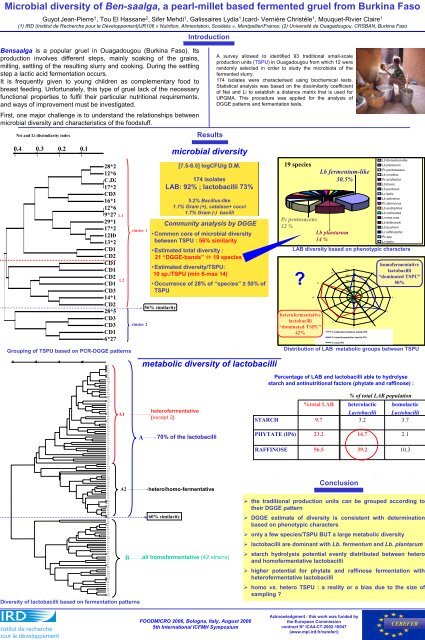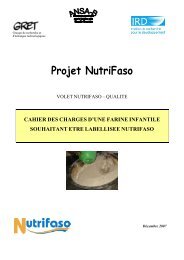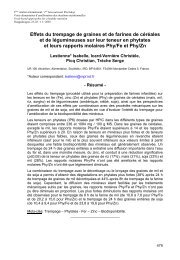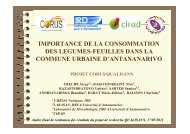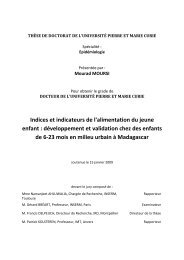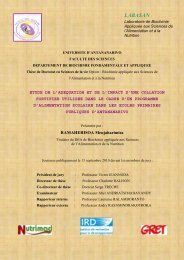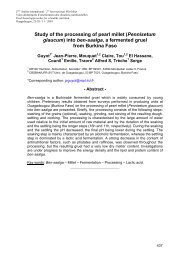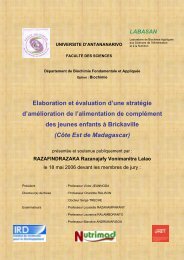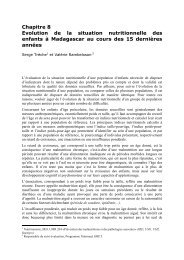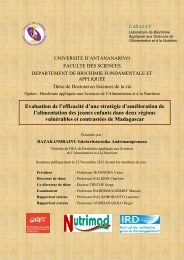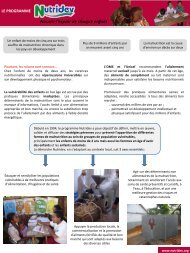Caractérisation préliminaire de la microflore lactique des pâtes fermentées de mil servant à la préparation du «ben-saalga», une bouillie traditionnelle burkinabè 0.4 0.3 0.2 0.1 2,3 3,5 5,1 3,9,1 3,10,2 6,9 4,11,1 4,11,2 7,3,2 1,10 2,17,1 1,5,2 11,11,1 3,7 3,10,1 11,4 3,6 1,9 6,6,2 4,10 1,5,1 5,4,1 5,4,2 1,6 10,9 4,6 4,7,1 4,7,2 7,9,2 5,11 12,11 1,7,2 4,9 7,9,1 6,10,2 10,2 10,4 11,3 11,5,1 11,6,1 11,10 11,2 8,4 6,3 6,4,1 6,5,2 6,5,1 5,10 2,9 5,3,1 4,1 4,3 4,4 4,2 5,9 5,8 2,12 2,11,1 7,8,1 2,4,1 2,13 7,10 10,8 8,9 8,12 9,10 9,2 9,11 10,10 9,4 8,1,2 12,6 8,1,1 8,5,1 9,1 9,3,1 9,5,2 8,8 10,3,2 8,7 8,10,2 8,10,1 7,5,1 12,4,2 12,8,1 12,9 12,3 12,1 9,7 7,1 5,6,1 12,10 Tou 1,2 <strong>El</strong> <strong>Hassane</strong>, Keleke 3 Simon, Mouquet 1,2 Claire, Traoré 1 Alfred S., Guyot 2 Jean Pierre (1) Université de Ouagadougou/UFR-SVT/ CRSBAN, Burkina Faso ; (2) IRD (Institut de Recherche pour le Développement)UR106 « Nutrition, Alimentation, Sociétés », Montpellier/France; (3) EPRAN (Équipe Pluridisciplinaire de Recherche en Alimentation et Nutrition) Pointe-Noire Congo Introduction Les bouillies fermentées à base de céréales consommées traditionnellement en Afrique de l’Ouest présentent des qualités sanitaires et nutritionnelles améliorées qui leur sont conférées par les ferments lactiques naturels. L’étude de ces microorganismes est essentielle car (i) ils sont un des déterminants importants de la stabilité et de la qualité des produits fermentés et (ii) leur nature contribue à la typicité d’un produit alimentaire fermenté. Dans le cadre d’une large étude qui porte sur l’analyse de la diversité microbienne dans les pâtes de mil utilisées dans la préparation du ben-saalga, nous avons effectué une caractérisation phénotypique de la microflore bactérienne de ces pâtes. Méthodologie ‣ les échantillons (pâtes fermentées) analysés ont été prélevés de manière stérile dans les récipients de décantation en fin de fermentation, auprès de 12 micro-ateliers de production sélectionnés de façon aléatoire parmi 93 ateliers, le milieu MRS a été utilisé pour les isolements et les cultures en routine ‣ Les isolats ont été caractérisés sur la base des caractères suivants : morphologie, coloration de Gram, catalase et des profils biochimiques (galeries API 50CHL) analysés par le logiciel APILAB plus ‣ Le type métabolique a été déterminé par dosage des acides acétique et lactique, et éthanol par HPLC ‣ la classification taxonumérique des isolats a été réalisée en établissant une matrice des distances à partir du calcul de l’indice de dissimilitude de Nei et Li. Basé sur cette matrice, un dendrogramme a été établi en utilisant l’algorithme UPGMA. Résultats 1.Numération de bactéries lactiques La numération de la microflore indique que la flore dominante est constituée de bactéries lactiques (BL). Le nombre de BL de pâtes fermentées des 12 ateliers varie entre 7,5 et 8,5 log(UFC/ g de matière sèche de la bouillie). Ces valeurs sont très inférieures aux concentrations rapportées pour certains produits fermentés similaires. 2. Caractérisation phénotypique des bactéries 2.1. Profil biochimique des isolats Une collection de 184 isolats a été constituée dont les caractéristiques sont indiquées dans le tableau 1. Tableau 1 : Principales caractéristiques des isolats Pourcentage d’isolats (%) Gram + 98 Catalase - 94 Gram + et Catalase - 92 Homofermentaire 58 Lactobacilles 80 glucose 100 fructose 100 maltose 72 saccharose 57 lactose 52 mélibiose 57 raffinose 69 92% des isolats sont à la fois Gram positif et catalase négative et sont donc présomptivement des bactéries lactiques. Leur appartenance au groupe de bactéries lactiques a été confirmée par l’analyse des produits de fermentation. 80% des isolats sont des lactobacilles dont 47% sont hétérofermentaires. Les principaux substrats fermentés sont le glucose, le fructose, le maltose, le saccharose, qui sont les principaux oses libres des céréales. L’utilisation du mélibiose et du raffinose par une majorité des BL suggère un potentiel naturel pour fermenter les α-galactosides. 2.2. Diversité et identification des isolats Figure 1 : Analyse de la diversité des souches de bactéries lactiques sur la base des caractères phénotypiques La figure 1 montre que la microflore lactique des pâtes fermentées présente une grande diversité. Cependant, deux groupes majeurs (A et B) peuvent être distingués à un niveau de coupure de 60% de similitude. Le groupe A comprend essentiellement des lactobacilles (70%), le sous-groupe A1 est majoritairement constitué de lactobacilles hétérofermentaires et le groupe B est exclusivement formé par des souches homofermentaires. Au total 19 espèces différentes ont été identifiées. Le groupe majoritaire (30,5% des isolats) est formé par des BL se rattachant à l’espèce Lactobacillus fermentum (L. fermentum sensus stricto et L. cellobiosus) suivi par des souches identifiées comme étant L. plantarum (14% des isolats) et comme Pediococcus pentosaceus (12%). L’analyse du positionnement des souches dans le dendrogramme (figure 1) a montré qu’il existait une grande diversité intra-espèce. Conclusion Ces résultats confirment la dominance des bactéries lactiques et en particulier celle des lactobacilles hétérofermentaires. La présence d’isolats capables d’utiliser les α-galactosides est un des caractères intéressants qui permet de justifier l’introduction de légumineuses avant fermentation. On pourrait ainsi espérer améliorer les teneurs en protéines et lipides en limitant naturellement les effets négatifs des α-galactosides, grâce à leur hydrolyse naturelle par la microflore lactique. 3,4 4,8,1 1,4 7,4 6,1 2,7,2 4,8,2 11,1 3,1 3,8 6,7 2,5 1,1 5,7 4,5 1,8 3,3 2,2 2,11,2 1,2 5,2 2,1 2,6 8,6 7,7 8,11 7,2 9,6 7,6 9,3,2 7,11 8,3 9,12 5,6,2 B2.1 B2.2 A1 A2 B1 B2 A B Institut de recherche pour le développement UFR-SVT/ CRSBAN Acknowledgment : this work was funded by the European Commission contract N° ICA4-CT-2002-10047 (www.mpl.ird.fr/cerefer/) CEREFER
0.4 0.3 0.2 0.1 2,3 3,5 5,1 3,9,1 3,10,2 6,9 4,11,1 4,11,2 7,3,2 1,10 2,17,1 1,5,2 4,8,2 11,11,1 3,7 3,10,1 11,4 3,6 1,9 6,6,2 4,10 1,5,1 5,4,1 5,4,2 1,6 10,9 4,6 4,7,1 4,7,2 7,9,2 5,11 12,11 1,7,2 4,9 7,9,1 6,10,2 10,2 10,4 11,3 11,5,1 11,6,1 11,10 11,2 8,4 6,3 6,4,1 6,5,2 6,5,1 5,10 2,9 5,3,1 4,1 4,3 4,4 4,2 5,9 5,8 2,2 2,11,2 2,12 2,11,1 7,8,1 2,4,1 2,13 7,10 10,8 8,9 8,12 9,10 9,2 9,11 10,10 9,4 8,1,2 7,2 9,6 12,6 8,1,1 8,5,1 9,1 9,3,1 9,3,2 7,11 9,5,2 8,8 10,3,2 8,7 8,10,2 8,10,1 7,5,1 12,4,2 12,8,1 12,9 12,3 12,1 9,7 9,12 5,6,2 7,1 5,6,1 12,10 Microbial diversity of Ben-saalga, a pearl-millet based fermented gruel from Burkina Faso Guyot Jean-Pierre 1 , Tou <strong>El</strong> <strong>Hassane</strong> 2 , Sifer Mehdi 1 , Galissaires Lydia 1 ,Icard- Vernière Christèle 1 , Mouquet-Rivier Claire 1 (1) IRD (Institut de Recherche pour le Développement)UR106 « Nutrition, Alimentation, Sociétés », Montpellier/France; (2) Université de Ouagadougou, CRSBAN, Burkina Faso Introduction Bensaalga is a popular gruel in Ouagadougou (Burkina Faso). Its production involves different steps, mainly soaking of the grains, milling, settling of the resulting slurry and cooking. During the settling step a lactic acid fermentation occurs. It is frequently given to young children as complementary food to breast feeding. Unfortunately, this type of gruel lack of the necessary functional properties to fulfil their particular nutritional requirements, and ways of improvement must be investigated. First, one major challenge is to understand the relationships between microbial diversity and characteristics of the foodstuff. Nei and Li dissimilarity index 0.4 0.3 0.2 0.1 28*27 12*6 C.D2 17*28 CD3. 16*16 12*63 9*27P 29*18 17*28 Grouping of TSPU based on PCR-DGGE patterns Diversity of lactobacilli based on fermentation patterns 1.1 12HC 13*26 CD11 CD2. CD1. CD1. CD2. CD1. CD3. 14*14 CD21 28*56 CD3. CD3. CD1. 6*27P 3,4 4,8,1 1,4 7,4 6,1 2,7,2 11,1 3,1 3,8 6,7 2,5 1,1 5,7 4,5 1,8 3,3 1,2 5,2 2,1 2,6 8,6 7,7 8,11 7,6 8,3 1.2 A1 A2 B cluster 1 cluster 2 A 56% similarity Results microbial diversity [7.5-8.5] logCFU/g D.M. 174 isolates LAB: 92% ; lactobacilli 73% 5.2% Bacillus-like 1.1% Gram (+), catalase+ cocci 1.7% Gram (-) bacilli Community analysis by DGGE •Common core of microbial diversity between TSPU : 56% similarity •Estimated total diversity : 21 “DGGE-bands” 19 species •Estimated diversity/TSPU: 10 sp./TSPU (min 6-max 14) •Occurrence of 28% of “species” ≥ 50% of TSPU metabolic diversity of lactobacilli heterofermentative (except 2) 70% of the lactobacilli hetero/homo-fermentative 60% similarity all homofermentative (42 strains) A survey allowed to identified 93 traditional small-scale production units (TSPU) in Ouagadougou from which 12 were randomly selected in order to study the microbiota of the fermented slurry. 174 isolates were characterised using biochemical tests. Statistical analysis was based on the dissimilarity coefficient of Nei and Li to establish a distance matrix that is used for UPGMA. This procedure was applied for the analysis of DGGE patterns and fermentation tests. 19 species Lb fermentum-like 30.5% Pc pentosaceus 12 % Lb plantarum 14 % LAB diversity based on phenotypic characters Distribution of LAB metabolic groups between TSPU Conclusion Lb fermentum-like Lb plantarum Pc pentosaceus Lb curvatus Pc acidilactici Lb brevis Lb pentosus Lc lactis Lb salivarius Pc damnosus Lb acidophilus Lb collinoides Ln mes.mes Lb delbruecki Lb buchneri Lc raffinolactis Pc spp Ln lactis Percentage of LAB and lactobacilli able to hydrolyse starch and antinutritional factors (phytate and raffinose) : STARCH PHYTATE (IP6) RAFFINOSE ? heterofermentative lactobacilli “dominated TSPU” 42% 10 11 %total LAB 9 9.7 23.2 56.5 12 8 % of total LAB population heterolactic homolactic Lactobacilli Lactobacilli 3.2 3.7 14.7 39.2 10.3 ‣ the traditional production units can be grouped according to their DGGE pattern ‣ DGGE estimate of diversity is consistent with determination based on phenotypic characters ‣ only a few species/TSPU BUT a large metabolic diversity ‣ lactobacilli are dominant with Lb. fermentum and Lb. plantarum ‣ starch hydrolysis potential evenly distributed between hetero and homofermentative lactobacilli ‣ higher potential for phytate and raffinose fermentation with heterofermentative lactobacilli ‣ homo vs. hetero TSPU : a reality or a bias due to the size of sampling ? 100.0 80.0 60.0 40.0 20.0 0.0 % heterofermentative lactob./PU % homofermentative lactob./PU % cocci/PU 1 7 2 6 homofermentative lactobacilli “dominated TSPU” 3 50% 5 4 2.1 nstitut de recherche our le développement FOODMICRO 2006, Bologna, Italy, August 2006 5th International ICFMH Symposium Acknowledgment : this work was funded by the European Commission contract N° ICA4-CT-2002-10047 (www.mpl.ird.fr/cerefer/) CEREFER
- Page 1 and 2:
N° d’ordre--------------/ UNIVER
- Page 3 and 4:
REMERCIEMENTS A Dieu les prières,
- Page 5 and 6:
SOMMAIRE LISTE DES FIGURES ET TABLE
- Page 7 and 8:
III.1.4. Enregistrement des cinéti
- Page 9 and 10:
LISTE DES FIGURES ET TABLEUAX FIGUR
- Page 11 and 12:
Article 5: Improving the nutritiona
- Page 13 and 14:
INTRODUCTION GENERALE
- Page 15 and 16:
Introduction générale la malnutri
- Page 17 and 18:
Introduction générale 2000; Dewey
- Page 19 and 20:
Revue Bibliographique et Cadre de l
- Page 21 and 22:
Revue Bibliographique et Cadre de l
- Page 23 and 24:
Revue Bibliographique et Cadre de l
- Page 25 and 26:
Revue Bibliographique et Cadre de l
- Page 27 and 28:
Revue Bibliographique et Cadre de l
- Page 29 and 30:
Revue Bibliographique et Cadre de l
- Page 31 and 32:
Revue Bibliographique et Cadre de l
- Page 33 and 34:
Revue Bibliographique et Cadre de l
- Page 35 and 36:
Revue Bibliographique et Cadre de l
- Page 37 and 38:
Revue Bibliographique et Cadre de l
- Page 39 and 40:
Revue Bibliographique et Cadre de l
- Page 41 and 42:
Revue Bibliographique et Cadre de l
- Page 43 and 44:
Revue Bibliographique et Cadre de l
- Page 45 and 46:
Revue Bibliographique et Cadre de l
- Page 47 and 48:
Revue Bibliographique et Cadre de l
- Page 49 and 50:
Revue Bibliographique et Cadre de l
- Page 51 and 52:
Revue Bibliographique et Cadre de l
- Page 53 and 54:
Revue Bibliographique et Cadre de l
- Page 55 and 56:
CHAPITRE II. MATERIELS ET METHODES
- Page 57 and 58:
Matériels et méthodes caractéris
- Page 59 and 60:
Matériels et méthodes • Prélev
- Page 61 and 62:
Matériels et méthodes différents
- Page 63 and 64:
Matériels et méthodes II.3.1.2. P
- Page 65 and 66:
Matériels et méthodes afin de blo
- Page 67 and 68:
Matériels et méthodes (1988). Les
- Page 69 and 70:
Matériels et méthodes III.2.2. Pr
- Page 71 and 72:
CHAPITRE III. CARACTERISTIQUES PHYS
- Page 73 and 74:
Résultats - Chapitre 3 Projet d’
- Page 75 and 76:
E.H. Tou et al. / International Jou
- Page 77 and 78:
E.H. Tou et al. / International Jou
- Page 79 and 80:
E.H. Tou et al. / International Jou
- Page 81 and 82:
E.H. Tou et al. / International Jou
- Page 83 and 84:
Projet d’article: Preliminary cha
- Page 85 and 86:
Projet d’article (24%) followed b
- Page 87 and 88:
Projet d’article profiles by API
- Page 89 and 90:
Projet d’article of lactobacilli
- Page 91 and 92:
Projet d’article Lactobacillus ce
- Page 93 and 94:
Projet d’article International Jo
- Page 95 and 96:
Projet d’article fermented foods.
- Page 97 and 98:
Résultats - Chapitre IV Améliorat
- Page 99 and 100:
Résultats - Chapitre IV conduit à
- Page 101 and 102:
Food processing at household and co
- Page 103 and 104:
Food processing at household and co
- Page 105 and 106:
Food processing at household and co
- Page 107 and 108:
Food processing at household and co
- Page 109 and 110:
Food Chemistry 100 (2007) 935-943 F
- Page 111 and 112:
E.H. Tou et al. / Food Chemistry 10
- Page 113 and 114:
E.H. Tou et al. / Food Chemistry 10
- Page 115 and 116:
E.H. Tou et al. / Food Chemistry 10
- Page 117 and 118:
E.H. Tou et al. / Food Chemistry 10
- Page 119 and 120:
Résultats - Chapitre 5 Améliorati
- Page 121 and 122:
ARTICLE IN PRESS LWT 40 (2007) 1561
- Page 123 and 124:
ARTICLE IN PRESS E.H. Tou et al. /
- Page 125 and 126:
ARTICLE IN PRESS E.H. Tou et al. /
- Page 127 and 128:
ARTICLE IN PRESS E.H. Tou et al. /
- Page 129 and 130:
ARTICLE IN PRESS E.H. Tou et al. /
- Page 131 and 132:
Discussion et Conclusion générale
- Page 133 and 134:
Discussion et Conclusion générale
- Page 135 and 136:
Discussion et Conclusion générale
- Page 137 and 138:
Discussion et Conclusion générale
- Page 139 and 140:
Discussion et Conclusion générale
- Page 141 and 142: Discussion et Conclusion générale
- Page 143 and 144: Références Bibliographiques REFER
- Page 145 and 146: Références Bibliographiques Burki
- Page 147 and 148: Références Bibliographiques De Ci
- Page 149 and 150: Références Bibliographiques Fröl
- Page 151 and 152: Références Bibliographiques Insti
- Page 153 and 154: Références Bibliographiques Macro
- Page 155 and 156: Références Bibliographiques Mouqu
- Page 157 and 158: Références Bibliographiques ‘
- Page 159 and 160: Références Bibliographiques Svanb
- Page 161 and 162: Références Bibliographiques Traor
- Page 163 and 164: Références Bibliographiques World
- Page 165 and 166: Annexes Liste des Annexes Annexe-1
- Page 167 and 168: Fiche d’observations Numéro de l
- Page 169 and 170: Fiche d’observations Numéro de l
- Page 171 and 172: Fiche d’observations Numéro de l
- Page 173 and 174: Fiche d’observations Numéro de l
- Page 175 and 176: Fiche d’observations Numéro de l
- Page 177 and 178: Fiche d’observations Volume total
- Page 179 and 180: Fiche d’observations Numéro de l
- Page 181 and 182: Annexe-2 Composition du milieu MRS-
- Page 183 and 184: Annexe-3 croissance, de l’émacia
- Page 185 and 186: Annexe-3 Filtration L’étape de f
- Page 187 and 188: Annexe-3 Le tableau II présente le
- Page 189 and 190: Annexe-3 de fermentation à savoir
- Page 191: Annexe-3 hydrolyse partielle de l
- Page 195 and 196: Essai de modification du procédé
- Page 197 and 198: Annexe-8 La première étape consis
- Page 199 and 200: Annexe-8 6. EVALUATION Enfin, aprè


